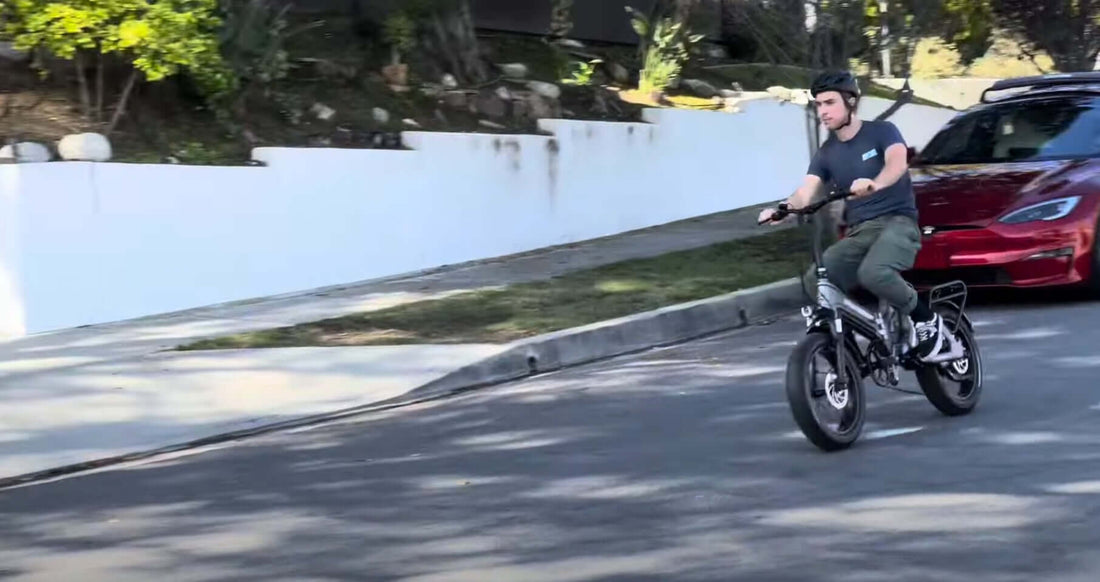Understanding Your Mihogo E-Bike's Water Resistance
IPX5 Rating Explained
All Mihogo e-bikes are built to the IPX5 water-resistant standard, meaning they resist water splashes from any direction and can handle light rain safely. This protection level ensures your electrical components remain secure during typical wet weather conditions.
What IPX5 Protects Against:
- Light to moderate rainfall
- Road spray and splash
- Accidental water exposure
What to Avoid:
- Prolonged heavy downpours
- Deep puddle submersion
- High-pressure water cleaning
Smart Technology Weather Features
Mihogo's advanced models like the ONE and Air Max feature IP67 waterproof interfaces with 90% hidden wiring design, providing superior protection for electrical components during wet conditions.
Mihogo Model Terrain Compatibility for Rain Riding
Best Models for Different Wet Terrains
Urban Commuting in Rain:
- Mihogo ONE Utility - Ideal for all-terrain urban riding with 167-mile range and puncture-proof steel-belted tires
- Mihogo Air Max - Perfect for city commutes with lightweight carbon fiber frame and 128-mile range
Off-Road Wet Conditions:
- Mihogo NX - Engineered for sand, snow, and rigorous trails with 20x4" robust tires and dual suspension system
Light Trail and Mixed Terrain:
- Mihogo RX 2.4 - Designed for versatile riding with 100-mile range capability and 23MPH top speed
Essential Pre-Ride Safety Checklist for Wet Weather
Battery and Electrical Safety
Ensure your battery is fully charged before riding and always dry battery contacts after wet rides to prevent moisture damage. Remove the battery post-ride and dry both the unit and storage compartment thoroughly.
Tire Preparation
Lower your tire pressure by 10 psi to increase contact surface area and improve traction on wet roads. This simple adjustment significantly enhances grip and stability.
Brake System Check
Inspect brake pads and test braking distance, as wet conditions increase stopping distances. All Mihogo models feature hydraulic disc brakes for superior wet weather performance.
Riding Techniques for Wet Conditions
Speed and Distance Management
Reduce your normal riding speed and maintain longer following distances, as wet roads require more time to brake safely. Avoid sudden acceleration or sharp turns that could cause sliding.
Navigation Hazards
Avoid These Wet Weather Dangers:
- Painted road markings and metal surfaces that become extremely slippery
- Deep puddles that could submerge motor or battery components
- Areas with rainbow patterns indicating oil presence
Advanced Riding Tips
Keep maximum tire contact with the road by avoiding leaning into corners and maintaining straight angles when crossing gutters or driveways.
Essential Rain Gear and Visibility Equipment
Waterproof Clothing System
Invest in waterproof jacket, gloves, and non-slip shoes with reflective elements for enhanced visibility and comfort. Layer clothing strategically to maintain warmth and dryness.
Lighting and Visibility
Use bright white front lights visible from 500+ feet and red tail lights for maximum visibility to other road users. Consider reflective tire sidewalls for additional side visibility.
Protective Accessories
- Fenders: Essential for preventing water spray that can damage bike components and keep you dry
- Clear Visor/Glasses: Prevent raindrops from obstructing vision while riding
- Waterproof Phone Mount: Protect navigation devices from moisture
Post-Ride Maintenance for Wet Weather
Immediate Cleaning Protocol
Clean your e-bike frame, battery terminals, and electrical components immediately after wet rides to prevent rust and corrosion. Use a clean, dry cloth rather than high-pressure water.
Battery Care
Remove the battery and dry it thoroughly along with the storage compartment. This critical step prevents moisture damage and extends battery life.
Chain and Moving Parts
Apply fresh chain lubricant after wet rides, as proper lubrication is more important than cleaning for maintaining smooth operation.
When NOT to Ride in Wet Conditions
Extreme Weather Situations
Avoid riding during heavy thunderstorms or torrential downpours for safety reasons. Seek shelter immediately if caught in severe weather.
Deep Water Hazards
Never ride through water that could submerge your motor or battery. If unavoidable, turn off electrical systems and walk the bike through, allowing complete drying before reactivation.
Frequently Asked Questions
Q: Can I wash my Mihogo e-bike with a hose? A: No, avoid pressure washing. Mihogo bikes resist water splashes but aren't designed for pressurized spray cleaning.
Q: What's the maximum water depth I can ride through? A: Avoid any water depth that could reach your motor or battery components. When in doubt, dismount and walk.
Q: Does rain riding void my warranty? A: Check your specific warranty terms, as some manufacturers include moisture damage clauses. Contact Mihogo directly for clarification.
Advanced Safety Features in Mihogo E-Bikes
Smart Weather Integration
Modern Mihogo models feature smartphone integration that can display real-time weather updates and navigation, helping you avoid severe weather conditions.
Enhanced Braking Systems
All Mihogo models include hydraulic disc brakes specifically designed for reliable performance in wet conditions, providing consistent stopping power regardless of weather.
Conclusion: Mastering Wet Weather E-Biking
Riding your Mihogo e-bike in the rain opens up year-round cycling opportunities when done safely. With proper precautions, quality rain gear, and understanding your bike's water resistance capabilities, wet weather riding becomes both safe and enjoyable.
Remember: preparation is key to safe rain riding. Check weather conditions, inspect your equipment, and never compromise on visibility or protective gear.
Ready to explore our complete range of weather-resistant e-bikes? Visit our e-bike collection to find your perfect rain-ready companion.
Related Resources:
- E-bike Battery Care Guide - Learn optimal battery maintenance for all weather conditions
- Urban Commuting Safety Tips - Master city riding techniques for daily commuters
External Learning Resources:
- Bicycle Safety Guidelines - Comprehensive safety information
- Weather Riding Techniques - Professional cycling advice
- E-bike Technology Explained - Technical insights and trends






